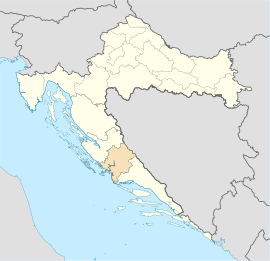Kijevo
| Kijevo | ||
|
||
|
|
||
| Basic data | ||
|---|---|---|
| State : |
|
|
| County : |
|
|
| Residents : | 417 (2011) | |
| Telephone code : | (+385) 022 | |
| Postal code : | 22 310 | |
| License plate : | ŠI | |
| Structure and administration (status: 2013, cf. ) |
||
| Community type : | local community | |
| Mayor : | Ivan-Stjepan Bajan ( HDZ ) | |
| Website : | ||
Kijevo is a village in the Šibenik-Knin County in Croatia .
Location and inhabitants
Kijevo is a small town in the Zagora between Knin and Vrlika . The village is located in the Šibenik-Knin County and had 417 inhabitants according to the 2011 census. All 417 inhabitants were Roman Catholics and known themselves as ethnic Croatians . The village is about ten kilometers south of the highest mountain in Croatia, Dinara (1831 m). Kijevo is also close to the source of the Cetina .
history
Croatian War (1991–1995)
In the context of the armed conflict after the break-up of Yugoslavia in 1991, Kijevo became the first village to be “ethnically cleansed” by paramilitary forces of the Krajina Serbs . The reason for the devastation was that the village was exclusively inhabited by Croats . At that time Kijevo had 1,261 inhabitants, of which 99.6% were Croatians. The surrounding towns of Polača, Civljane and Cetina , however, were mostly Serbian.
At that time, the Croatian Ministry of the Interior set up a police station in this village, which is why Kijevo was quickly surrounded by rebellious Serb troops. The troops of the head of the self-proclaimed Serbian Republic of Krajina , Milan Martić , erected barricades on August 17, 1991 and refused any access to the village. On August 18, 1991, Martić issued an ultimatum to the police and the residents of Kijevo, in which he asked them to leave the village.
Finally, the Yugoslav People's Army under the leadership of Ratko Mladić attacked the village with large guns on August 26 and 27, 1991. The village was conquered, which forced the nearby Croatian troops to withdraw from Drniš . The remaining Croatian population fled after the artillery destroyed most of the houses. Kijevo was razed to the ground, no house was left.
Belgrade TV reporter Vesna Jugović recorded these events. Martić and Mladić were charged with "ethnic cleansing" at the International Criminal Court in The Hague in this case.
After the reconquest in 1995 by Croatian troops, the place was largely rebuilt. Near the village, the two steeples of the village church now protrude behind the hills, which can be seen from afar. The Catholic Church was the first structure to be rebuilt in Kijevo after the war. In the meantime, many people have returned to Kijevo.
photos
Web links
Individual evidence
- ↑ 2011 census by citizenship, ethnic group and mother tongue - Šibenik-Knin County , pages 46 to 47, Croatian State Statistical Office , dzs.hr, accessed on October 1, 2019
- ↑ Population by ethnic group, 2011 census , Croatian State Statistics Office , dzs.hr, accessed on October 1, 2019
- ↑ Ethnic cleansing



